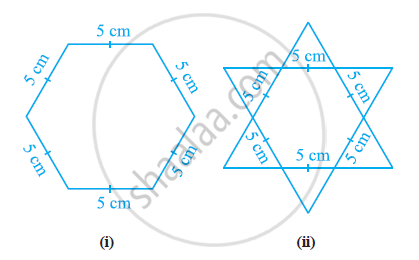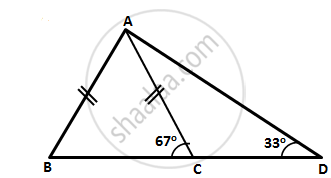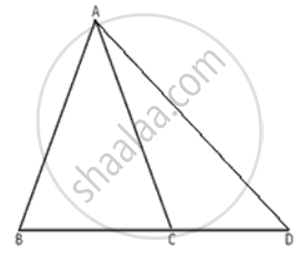Advertisements
Advertisements
Question
In the following figure, write BC, AC, and CD in ascending order of their lengths.
Solution

In ΔABC,
∠BAC < ∠ABC
BC < AC ....( 1 )
Now, ∠ACB = 180° - ∠ABC - ∠BAC
∠ACB = 180° - 73° - 47°
∠ACB = 60°
Now, ∠ACD = 180° - ∠ACB
∠ACD = 180° - 60° = 120°
Now, in ΔACD,
∠ADC = 180° - ∠ACD - ∠CAD
∠ADC = 180° - 120° - 31°
∠ADC = 29°
Since ∠ADC < ∠CAD, we have
AC < CD ....( 2 )
From ( 1 ) and ( 2 ), we have
BC < AC < CD.
APPEARS IN
RELATED QUESTIONS
AB and CD are respectively the smallest and longest sides of a quadrilateral ABCD (see the given figure). Show that ∠A > ∠C and ∠B > ∠D.

In a huge park people are concentrated at three points (see the given figure):

A: where there are different slides and swings for children,
B: near which a man-made lake is situated,
C: which is near to a large parking and exit.
Where should an ice-cream parlour be set up so that maximum number of persons can approach it?
(Hint: The parlor should be equidistant from A, B and C)
Complete the hexagonal and star shaped rangolies (see the given figures) by filling them with as many equilateral triangles of side 1 cm as you can. Count the number of triangles in each case. Which has more triangles?

How had the position of women improved in our country since independence ? Explain with examples.
In the following figure, write BC, AC, and CD in ascending order of their lengths.
"Issues of caste discrimination began to be written about in many printed tracts and essays in India in the late nineteenth century." Support the statement with two suitable examples.
Arrange the sides of the following triangles in an ascending order:
ΔDEF, ∠D = 38°, ∠E = 58°.
ΔABC is isosceles with AB = AC. If BC is extended to D, then prove that AD > AB.
ABCD is a quadrilateral in which the diagonals AC and BD intersect at O. Prove that AB + BC + CD + AD < 2(AC + BC).
In the given figure, T is a point on the side PR of an equilateral triangle PQR. Show that RT < QT
